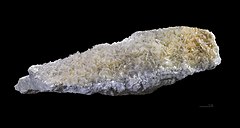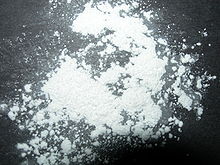| Talc |

Crystals of talc
|
| General |
| Category |
Silicate mineral |
Formula
(repeating unit) |
Mg3Si4O10(OH)2 |
| Strunz classification |
9.EC.05 |
| Crystal system |
monoclinic or triclinic[1] |
| Unit cell |
a = 5.291 Å, b = 9.173 Å
c = 5.290 Å; α = 98.68°
β = 119.90°, γ = 90.09°; Z = 2 or
a = 5.287 Å, b = 9.158 Å
c = 18.95 [Å], β = 99.3°; Z = 4[2] |
| Identification |
| Color |
Light to dark green, brown, white, grey |
| Crystal habit |
Foliated to fibrous masses, rare as platey to pyramidal crystals |
| Crystal symmetry |
Either monoclinic 2m or triclinic1[2] |
| Cleavage |
Perfect on {001} basal cleavage |
| Fracture |
Flat surfaces (not cleavage), fracture in an uneven pattern |
| Tenacity |
Sectile |
| Mohs scalehardness |
1 (defining mineral) |
| Luster |
Waxlike or pearly |
| Streak |
White to pearl black |
| Diaphaneity |
Translucent |
| Specific gravity |
2.58 to 2.83 |
| Optical properties |
Biaxial (-) |
| Refractive index |
nα = 1.538 – 1.550
nβ = 1.589 – 1.594
nγ = 1.589 – 1.600 |
| Birefringence |
δ = 0.051 |
| Pleochroism |
Weak in dark varieties |
| Ultravioletfluorescence |
Short UV=orange yellow, long UV=yellow |
| References |
[2][3][4] |
Talc is a clay mineral composed of hydrated magnesium silicate with the chemical formula H2Mg3(SiO3)4 or Mg3Si4O10(OH)2. In loose form, it, along with corn starch, is one of the most widely used substances known as baby powder (in the case of talc, often called simply talcum powder). It occurs as foliated to fibrous masses, and in an exceptionally rare crystal form. It has a perfectbasal cleavage, and the folia are non-elastic, although slightly flexible. It is the softest known mineral and listed as 1 on the Mohs hardness scale. As such, it can be easily scratched by a fingernail. It has a specific gravity of 2.5–2.8, a clear or dusty luster, and is translucent to opaque. Talc is not soluble in water, but is slightly soluble in dilute mineral acids.[citation needed] Its color ranges fromwhite to grey or green and it has a distinctly greasy feel. Its streak is white.
Soapstone is a metamorphic rock composed predominantly of talc.
Etymology[edit]
The word talc derives from Medieval Latin talcus, which in turn originates from Arabic: طلق ṭalq which in turn was derived fromPersian: تالک tālk. In the ancient times the word was used for various related minerals, including talc, mica and selenite.[5]
Formation[edit]

A block of talc
Talc is a metamorphic mineral that results from the metamorphism of magnesian minerals such as serpentine, pyroxene,amphibole, olivine, in the presence of carbon dioxide and water. This is known as talc carbonation or steatization and produces a suite of rocks known as talc carbonates.
Talc is primarily formed via hydration and carbonation via the following reaction;
- serpentine2 Mg3Si2O5(OH)4 + carbon dioxide3CO2 → talcMg3Si4O10(OH)2 + magnesite3 MgCO3 + water3 H2O
Talc can also be formed via a reaction between dolomite and silica, which is typical of skarnification of dolomites via silica-flooding in contact metamorphic aureoles;
- dolomite3 CaMg(CO3)2 + silica4 SiO2 + waterH2O → talcMg3Si4O10(OH)2 + calcite3 CaCO3 + carbon dioxide3 CO2
Talc can also be formed from magnesian chlorite and quartz in blueschist and eclogite metamorphism via the following metamorphic reaction:
- chlorite + quartz → kyanite + talc + water
In this reaction, the ratio of talc and kyanite depends on aluminium content, with more aluminous rocks favoring production of kyanite. This is typically associated with high-pressure, low-temperature minerals such as phengite, garnet, glaucophane within the lower blueschist facies. Such rocks are typically white, friable, and fibrous, and are known as whiteschist.
Talc is a tri-octahedral layered mineral; its structure is similar to pyrophyllite, but with magnesium in the octahedral sites of the composite layers.[1]
Occurrence[edit]

Talc output in 2005
Talc is a common metamorphic mineral in metamorphic belts that contain ultramafic rocks, such as soapstone (a high-talc rock), and within whiteschist and blueschist metamorphic terranes. Prime examples of whiteschists include the Franciscan Metamorphic Belt of the western United States, the western European Alps especially in Italy, certain areas of the Musgrave Block, and some collisional orogens such as the Himalayas, which stretch along Pakistan, India, Nepal andBhutan.
Talc carbonate ultramafics are typical of many areas of the Archaean cratons, notably thekomatiite belts of the Yilgarn Craton in Western Australia. Talc-carbonate ultramafics are also known from the Lachlan Fold Belt, easternAustralia, from Brazil, the Guiana Shield, and from the ophiolite belts of Turkey, Oman and the Middle East.
Notable economic talc occurrences include the Mount Seabrook talc mine, Western Australia, formed upon a polydeformed, layered ultramafic intrusion. The France-based Luzenac Group is the world's largest supplier of mined talc. Its largest talc mine at Trimouns near Luzenac in southern France produces 400,000 tonnes of talc per year, representing 8% of world production.[6]

Talcum powder

The structure of talc is composed of Si2O5 sheets with magnesium sandwiched between sheets in octahedral sites.
Talc is used in many industries—including paper making, plastic, paint and coatings, rubber, food, electric cable, pharmaceuticals, cosmetics, and ceramics. A coarse grayish-green high-talc rock is soapstone or steatite, used for stoves, sinks, electrical switchboards, crayons, soap, etc. It is often used for surfaces of lab counter tops and electrical switchboards because of its resistance to heat, electricity and acids. Talc finds use as a cosmetic (talcum powder), as a lubricant, and as a filler in paper manufacture. Talc, with heavy refinement, has been used in baby powder, an astringent powder used to prevent rashes on the area covered by a diaper. The American Academy of Pediatrics recommends that parents not use baby powder because it poses a risk of respiratory problems—including breathing trouble and serious lung damage if the baby inhales it. The particles are so small that it is difficult to keep them out of the air while applying the powder. Zinc oxide-based ointments are a much safer alternative.[7][8]
It is also often used in basketball to keep a player's hands dry. Most tailor's chalk, or French chalk, is talc, as is the chalk often used forwelding or metalworking.
Talc is also used as food additive or in pharmaceutical products as a glidant. In medicine talc is used as a pleurodesis agent to prevent recurrent pleural effusion or pneumothorax. In the European Union the additive number is E553b.
Due to its low shear strength, talc is one of the oldest known solid lubricants. There is also a limited use of talc as friction-reducing additive in lubricating oils.[9]
Talc is widely used in the ceramics industry in both bodies and glazes. In low-fire art-ware bodies it imparts whiteness and increases thermal expansion to resist crazing. In stonewares, small percentages of talc are used to flux the body and therefore improve strength and vitrification. It is a source of MgO flux in high temperature glazes (to control melting temperature). It is also employed as a matting agent in earthenware glazes and can be used to produce magnesia mattes at high temperatures.
ISO standard for quality (ISO 3262)
| Type | Talc content min. wt% | Loss on ignition at 1000 °C, wt % | Solubility in HCl, max. wt % |
| A |
95 |
4 – 6.5 |
5 |
| B |
90 |
4–9 |
10 |
| C |
70 |
4–18 |
30 |
| D |
50 |
4–27 |
30 |
Patents are pending on the use of magnesium silicate as a cement substitute. Its production requirements are less energy-intensive than ordinary Portland cement (at a heating requirement of around 650 °C for talc compared to 1500 °C for limestone to produce Portland cement), while it absorbs far more carbon dioxide as it hardens. This results in a negative carbon footprint overall, as the cement substitute removes 0.6 tonnes of CO2 per tonne used. This contrasts with a positive carbon footprint of 0.4 tonne per tonne of conventional cement.[8]
Talc is used in the production of the materials that are widely used in the building interiors such as base content paints in wall coatings. Other areas that utilize talc to a great extent are organic agriculture, food industry, cosmetics, and hygiene products such as baby powder and detergent powder.
Talc is sometimes used as an adulterant to illegal heroin, to expand volume and weight and thereby increase its street value. With intravenous use, it may lead to talcosis, agranulomatous inflammation in the lungs.
Sterile talc powder[edit]
Sterile talc powder (NDC 63256-200-05) is a sclerosing agent used in the procedure of pleurodesis. This can be helpful as a cancer treatment to prevent pleural effusions (an abnormal collection of fluid in the space between the lungs and the chest wall). It is inserted into the space via a chest tube, causing it to close up, so fluid cannot collect there. The finished product has been sterilized by gamma irradiation.
Talc powder is a household item, sold globally for use in personal hygiene and cosmetics. Suspicions have been raised that its use contributes to certain types of disease, mainly cancers of the ovaries and lungs. It is classified in the same 2B category in the IARC listing as mobile phones and coffee. Reviews by Cancer Research UK and the American Cancer Society conclude that some studies have found a link, but other studies have not.[10][11]
The studies discuss pulmonary issues,[12] lung cancer,[13][14] and ovarian cancer.[15] One of these, published in 1993, was a US National Toxicology Program report, which found that cosmetic grade talc containing no asbestos-like fibres was correlated with tumor formation in rats forced to inhale talc for 6 hours a day, five days a week over at least 113 weeks.[13] A 1971 paper found particles of talc embedded in 75% of the ovarian tumors studied.[16] Research published in 1995 and 2000 concluded that it was plausible that talc could cause ovarian cancer, but there was no conclusive evidence.[17][18]
Industrial grade[edit]
In the United States, the Occupational Safety and Health Administration and National Institute for Occupational Safety and Health have set occupational exposure limits to respirable talc dusts at 2 mg/m3 over an eight-hour workday. At levels of 1000 mg/m3, inhalation of talc is considered immediately dangerous to life and health.[19]
Food grade[edit]
The US Food and Drug Administration (FDA) considers talc (magnesium silicate) to be generally recognized as safe (GRAS) for use as an anti-caking agent in table salt in concentrations smaller than 2%.[20]
Asbestos link[edit]
One particular issue with commercial use of talc is its frequent co-location in underground deposits with asbestos ore. Stringent quality control since 1976, including separating cosmetic and food-grade talc from "industrial" grade talc, has eliminated this issue, but it remains a potential hazard requiring mitigation in the mining and processing of talc.[21] A 2010 US FDA survey failed to find asbestos in a variety of talc-containing products.[22]
Litigation[edit]
In February 2016, as the result of a lawsuit against Johnson & Johnson (J&J), a St. Louis jury awarded $72 million to the family of an Alabama woman who died from ovarian cancer. The family claimed that the use of talcum powder was responsible for her cancer. In May 2016, a South Dakota woman was awarded $55 million as the result of another lawsuit against J&J.[23] The woman had used Johnson & Johnson’s Baby Powder for more than 35 years before being diagnosed with ovarian cancer in 2011. There are at least 1,200 other talcum powder-related lawsuits pending.[24]